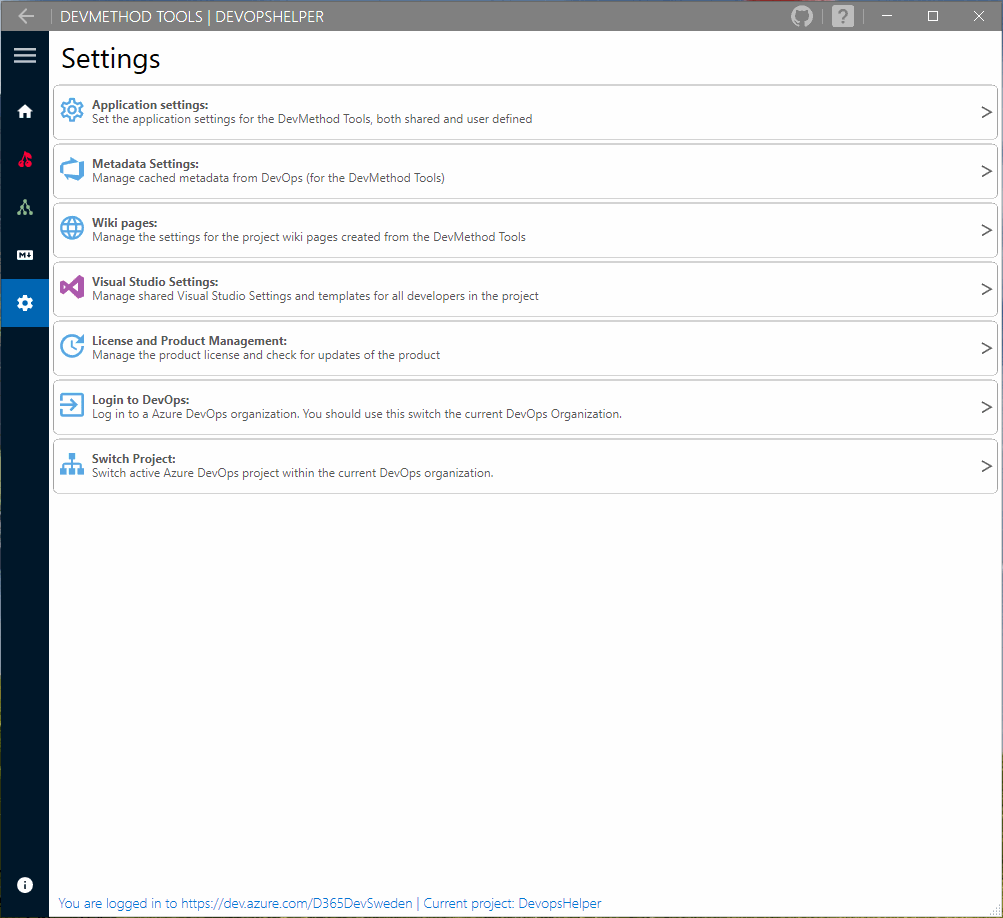Application settings
Project Settings:
The project settings are read only, this is only information about the current DevOps organization (URL) and the current active project.

Azure Storage Settings:
This section is dedicated to configuring the connection to Azure Storage. You can input the necessary details such as the container, folder, and connection string. After entering this information, it is automatically secured - both hidden and encrypted - to ensure the safety of your connection data. This feature not only protects your connection details but also facilitates effortless sharing with team members by exporting the setup information into a file. Simply click the “Export Azure Connection setup to a file” button to generate this file once you have completed the setup.
In instances where the connection information is not displayed (as it is hidden for security reasons), a setup button will be visible. Clicking this button will prompt a warning message, informing you that proceeding will erase the existing connection setup.
For your convenience, the current container and folder names are always displayed in this section, providing you with quick and easy reference to your active Azure Storage locations.

Wiki query generation options:
This segment focuses on configuring the settings for generating queries in the Wiki. It's important to note that all queries should be stored in the 'Shared Queries' folder or within its subfolders. This organization is crucial for maintaining a structured and accessible query database.
While the option to disable query creation is available, it is generally not advisable. Opting to deactivate this feature might be suitable for those preferring exclusively markdown-based lists in their reports. However, keep in mind that this could limit the versatility and depth of your report generation capabilities.
Additionally, you have the flexibility to customize your queries. For instance, you can create a single query that encompasses both bugs and work items classified under the 'Microsoft.RequirementCategory'. This is achieved by disabling the creation of separate bug queries and include both types in the query.

Field validation and DevOps update:
Field validation is a feature you can choose to implement based on your project needs. To utilize it, simply select the desired field from the provided lists. If field validation is not required for your workflow, you may leave these lists empty.
Release field:
The release field is particularly useful when you have a custom or standard field that you want to automatically apply to all related work items during the generation of release notes. This feature ensures consistency and accuracy across your documentation.

Branch field:
This feature is currently in an 'experimental' phase, meaning its functionality might vary due to the diverse ways branches can be set up. It employs three different methods to determine the current branch you are working on in Visual Studio. The primary goal is to alert developers if they are working on an incorrect branch, for example, mistakenly working on the main branch instead of a development branch. It's important to note that DevOps work items do not inherently include a branch field, so a custom field must be added to utilize this function.

Task validation field:
The task validation field is crucial for verifying change sets. This field is a vital component of the DevMethod Tools, so it should not be overlooked.
A common practice is to use the 'Activity' field with a specific value, such as 'Testing'.
This indicates that the task is for testing purposes. If the task's status category does not align with 'Completed' or 'Removed', a warning is issued. The value list displays possible options for this field.
Note: if you select 'Activity', there must be at least one task in your DevOps data with the value you intend to use.

Automatic task state update:
This option will automatically set the tasks of a selected value to the selected state if the state fulfilling the condition is not already set (the state of the task is still in the Proposed state category). This feature is particularly useful for ensuring that tasks are always in the correct state, without the need for manual intervention.

Optional settings:
This feature will automatically filter out the FI transactions during the analysis of the change sets, if not set you must use the filter button to hide these transactions when you are working with the change sets.

This option will keep the side menu visible at all times

Customize the application's color scheme to your preference, either by selecting custom colors or by following the default Windows app mode.
You can specify a default path for saving and importing settings files.

Set the color of the grid lines with warnings for unfinished work.

Buttons:
Save Settings:
Unlike other forms in the application, settings in this section are not saved automatically when you exit. It's important to click the 'Save settings' button to ensure your changes are applied. Remember, these settings are shared across all users of the application, except for individual preferences such as color settings, optional settings file path, and license details.
Export Azure connection setup to a file:
This functionality allows you to export your Azure connection setup into an encrypted file. This file can then be shared with other team members, facilitating a smoother setup process for new users of the application.
